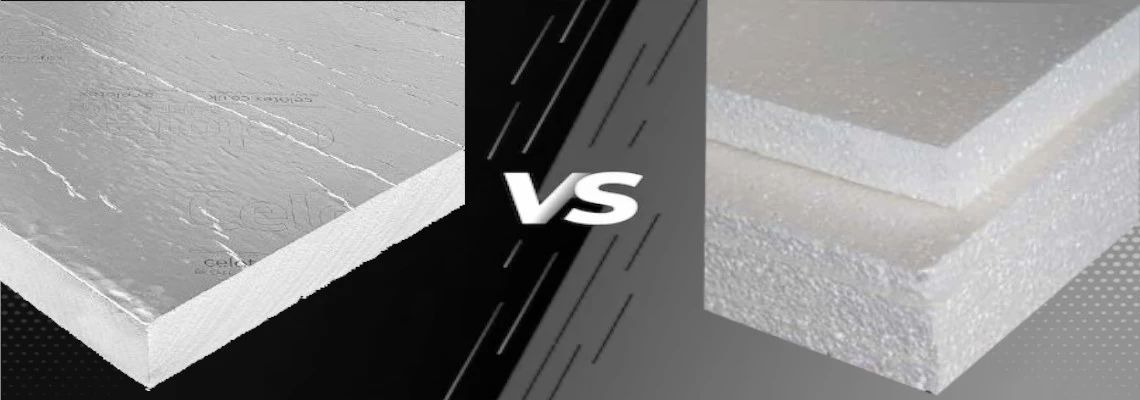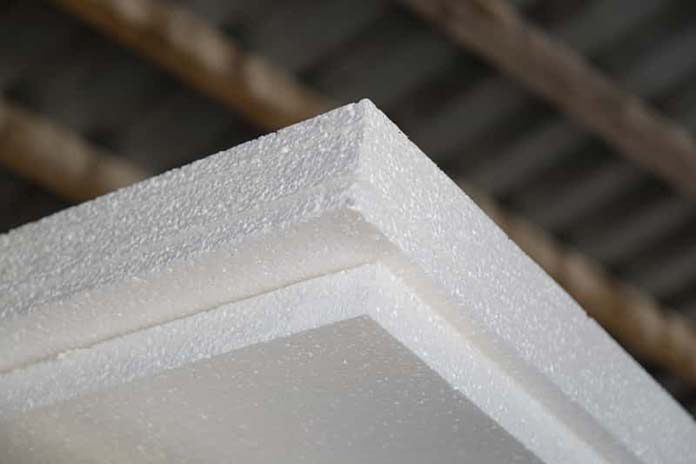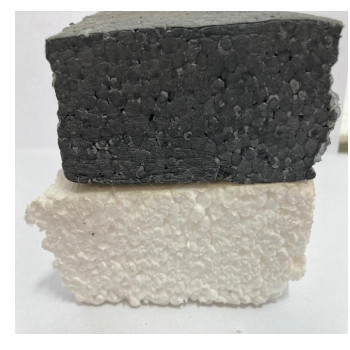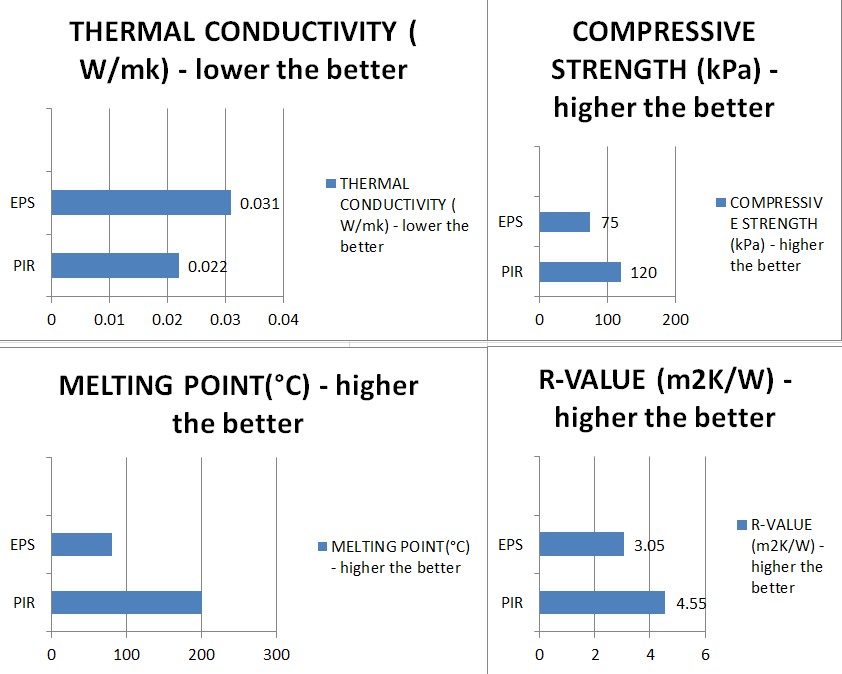
INSULATION SHOWDOWN: PIR SHEETS VS. POLYSTYRENE (STYROFOAM)*
PIR sheets are widely popular in the UK, but their competitor, polystyrene, is significantly cheaper. In this article, we aim to answer all your burning questions regarding the comparison between these two insulation materials. Join us as we delve into the pros and cons of each option to determine whether PIR, such as Celotex, is a better choice than polystyrene (Styrofoam).

 Table of contents
Table of contents
INSULATION SHOWDOWN: PIR SHEETS VS. POLYSTYRENE (STYROFOAM)
PIR vs POLYSTYRENE INSTALLATION
PIR vs POLYSTYRENE APPLICATION
PIR vs POLYSTYRENE PRICE
PIR vs POLYSTYRENE HISTORY
PIR vs POLYSTYRENE MELTING POINT
PIR vs POLYSTYRENE R-VALUE
CONCLUSION
PIR vs POLYSTYRENE INSTALLATION
 Although the installation processes for PIR insulation and polystyrene seem similar, there are significant differences between the two materials. PIR insulation is coated on both sides with aluminium foil, which has excellent insulation properties. However, the foil can sometimes make installation challenging. The PIR insulation foil is printed with measurement marks every 100mm, which simplifies copying dimensions without requiring a measuring tape. Polystyrene lacks this convenience.
Although the installation processes for PIR insulation and polystyrene seem similar, there are significant differences between the two materials. PIR insulation is coated on both sides with aluminium foil, which has excellent insulation properties. However, the foil can sometimes make installation challenging. The PIR insulation foil is printed with measurement marks every 100mm, which simplifies copying dimensions without requiring a measuring tape. Polystyrene lacks this convenience.
Cutting polystyrene is similar to cutting bread, while PIR insulation requires a bit more care, like cutting low-quality wood. During installation, bits of PIR insulation may cause respiratory irritation, while polystyrene tends to cling to clothing and produce static.
While the tools used for installation are similar for both PIR insulation and polystyrene, the foil on PIR insulation makes it more difficult to handle than polystyrene.
If a piece of polystyrene is cut too large, it can be easily shaved down to the desired size using a rasp. However, this isn't possible with PIR insulation. If a PIR board is cut too large, it cannot be trimmed down to size, and a new piece will need to be cut. This process can be time-consuming, as the margin for error is more significant. Cutting PIR insulation requires more precision and care, and it can take longer to achieve the correct size compared to polystyrene.
PIR can be installed almost without instructions, while polystyrene raises many questions regarding its cutting method. We have already described how to cut PIR insulation and polystyrene in two separate articles. You can learn more by clicking on the below articles.
HOW TO CUT A PIR INSULATION BOARD?
The winner in the installation category is polystyrene.
WINNER: Polystyrene✔
PIR vs POLYSTYRENE APPLICATION
 PIR has become very versatile and popular in the UK for good reason. Firstly, it is a clean material to work with, which is beloved by Londoners. This has made it readily available in stores such as B&Q, Wickes, Travis Perkins, and Selco. Its properties make it suitable for almost all types of applications, including floors, walls, ceilings, attics, and roofs.
PIR has become very versatile and popular in the UK for good reason. Firstly, it is a clean material to work with, which is beloved by Londoners. This has made it readily available in stores such as B&Q, Wickes, Travis Perkins, and Selco. Its properties make it suitable for almost all types of applications, including floors, walls, ceilings, attics, and roofs.
On the other hand, due to its flammability, polystyrene is rarely used for wall insulation. Additionally, it is loved by mice and other rodents. XPS extruded polystyrene, a variation of polystyrene, is unrivalled for use on floors. Its compressive strength allows it to be used under heavy loads, in places such as car parks and heavy concrete slabs. Its hardness ranges from 70kPa to 900kPa, with 70kPa being the softest and 900kPa being the hardest. For comparison, PIR insulation board has a compressive strength of 150kPa max.
The foil on both sides of the PIR sheet allows for the non-use of a vapour control barrier, whereas in polystyrene, this is already required, which slightly raises the cost of the investment. Polystyrene cannot serve as an insulating material in the presence of significant temperatures, as this may cause it to deteriorate, not to mention its potential for spontaneous combustion at 80 degrees Celsius. Although polystyrene is delivered in smaller pieces, unlike PIR's 8x4 sheets, it is rarely used in ceilings due to its poor acoustics. If we want to reduce the noise in the ceiling, polystyrene will not be suitable for this purpose.
PIR's advantage over polystyrene in applications results from its double-sided aluminium foil. It holds the sheet in one piece, does not crumble as easily, reflects heat, and can serve as a vapour control layer. It has squares marked every 100mm, which makes it easier to cut.
For a perfect example, let's say we're standing on a ladder trying to see if a lying waste piece on the ground is sufficient to fill the missing space. From a distance, we can estimate the length of the waste piece based on the number of squares. One square is 10cm, two squares are 20cm, and so on. Therefore, the winner in terms of application is PIR.
WINNER: PIR✔

PIR vs EPS

PIR vs POLYSTYRENE PRICE
The price of polystyrene for 100mm thickness is around £19 per m2, while PIR costs £23 per m2 for the same thickness. However, this doesn't necessarily mean it's more expensive! On the contrary, its excellent thermal insulation properties (λ–value 0.022 W/mk - the lower, the better) allow for reducing the thickness of the material used, which makes it, in some cases, even cheaper than polystyrene. For example, using 60mm PIR instead of 100mm polystyrene will give us the same effects. The cost of 60mm PIR will be around £15 per m2, automatically making it cheaper than polystyrene while achieving the same results. Again, PIR insulation sheet is the winner.
WINNER: PIR✔
PIR vs POLYSTYRENE HISTORY
PIR insulation has been well-known in the UK market for quite some time. Almost everyone has heard of large companies producing this type of insulation, including Celotex, Xtratherm, Kingspan, IKO, and Recticel. In fact, this product has been on the market for over 70 years. In comparison, polystyrene insulation has been on the market for only 30 years. We still do not know today what its effects may have on us, our health, our homes, etc. However, its production is carried out by well-known brands such as Jablite and Kingspan.
Let's establish that the winner in this category should be PIR due to its 40-year difference in history.
WINNER: PIR✔
PIR vs POLYSTYRENE MELTING POINT
Polystyrene (EPS) has a melting point of around 80°C, which means it can easily melt or deform when exposed to high temperatures. This makes it unsuitable for applications where high temperatures may be a concern, such as in roofing applications where the material may be exposed to direct sunlight.
PIR, on the other hand, has a much higher melting point of around 200°C, which makes it more resistant to high temperatures. This makes it a better choice for applications where temperature resistance is important.
WINNER: PIR✔
PIR vs POLYSTYRENE R-VALUE
The R-value is a measure of a material's thermal resistance. The higher the R-value, the better the insulation performance. The R-value for PIR insulation with a thickness of 100mm is 4.55m2K/W, while for polystyrene, it is 3.05m2K/W.
The percentage difference in R-value between PIR insulation and polystyrene with a thickness of 100mm is approximately 32%.
This means that PIR insulation is more effective at resisting heat flow than polystyrene, which can result in better energy efficiency and cost savings in heating and cooling.
For example, suppose you have two identical buildings, one insulated with PIR and the other with polystyrene, both heated to the same temperature. The building with PIR insulation will require less energy to maintain the temperature due to its higher R-value, resulting in lower energy bills.
Additionally, PIR insulation's higher R-value means it can achieve the same level of thermal performance with less material thickness compared to polystyrene. This can be especially beneficial in applications where space is limited, such as in a roof or wall cavity, where every millimetre counts.
WINNER: PIR✔
CONCLUSION
In conclusion, after comparing PIR and polystyrene insulation in terms of their price, history, melting point, and R-value, it is clear that PIR is the clear winner. Despite being slightly more expensive than polystyrene, PIR offers better thermal insulation properties and can be used in thinner layers, making it a cost-effective option in the long run. Additionally, with a much higher melting point than polystyrene, PIR is a safer option for insulation in buildings. Its 70-year history in the market also attests to its reliability and effectiveness. Overall, PIR insulation proves to be a better choice for those seeking a reliable, safe, and cost-effective thermal insulation solution for their buildings.
Related articles:
HOW TO INSTALL INSULATED PLASTERBOARD?
DIFFERENCE BETWEEN EPS AND XPS INSULATION BOARDS
FEEL THE DIFFERENCE WITH THE XPS BOARDS
*All the information provided in the content published on Insulationgo blog is for informational and educational purposes only. Insulationgo LTD makes every effort to ensure the accuracy and timeliness of the content, but we do not assume any responsibility for any errors or omissions.
The information presented on this blog should not be considered as professional advice or a substitute for consulting relevant experts. Before making any purchase decisions or taking action based on the information presented here, it is strongly recommended to contact the product manufacturer directly to verify the details and ensure its suitability for your specific needs.
By using this blog, you acknowledge and agree that Insulationgo LTD shall not be held liable for any damages, losses, or inconveniences arising from the use or reliance on the information provided herein. This limitation of liability applies to all users of the blog, including but not limited to visitors, readers, and subscribers.










































































































